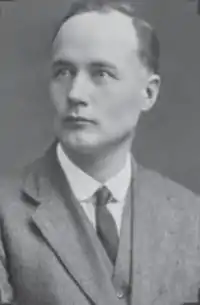John William Bews | |
|---|---|
 | |
| Born | 16 December 1884 Kirkwall, Orkney Islands, Scotland |
| Died | 10 November 1938 (aged 53) Pietermaritzburg, South Africa |
| Nationality | Scottish |
| Occupation | botanist |
| Notable work | Plant Forms and Their Evolution in South Africa, The Grasses and Grasslands of South Africa |
John William Bews (16 December 1884 — 10 November 1938) was a Scottish born South African botanist.
Early life
Bews was born in Kirkwall on the Orkney Islands of Scotland. His parents were farmers. He did his schooling in Kirkwall and later studied mathematics, natural philosophy, chemistry, geology, Latin, English and logic at Edinburgh University. He took a second degree in botany, chemistry and geology in 1907.[1][2]
Botanical work
In 1909 Bews was appointed professor of botany and geology at the newly established Natal University College in Pietermaritzburg, South Africa.[3][4] Originally intending to study plant physiology, the challenges of a new and under-resourced laboratory and the new (to him) vegetation of the Natal Midlands meant that he changed the direction of his study to field work.[1]
The standard author abbreviation Bews is used to indicate this person as the author when citing a botanical name.[5]
Philosophy
Bews was a protege of General Jan Smuts and was influenced by his ideas on holism. "Botany, patriotism and the politics of national unity were bound up... Bews made this links explicit, recommending that ecologists use the language of sociology to describe relationships in the plant world".[6][7]
Works
- Plant Forms and Their Evolution in South Africa. Longman, Green. 1925. ISBN 9780598901552.
- The Grasses and Grasslands of South Africa. P. David & Sons. 1918.
- Researches on the Vegetation of Natal. Government Printer. 1923.
- The Plant Ecology of the Drakensberg Range. 1917.
Commemoration
The Bews Herbarium on the Pietermaritzburg campus of the University of Natal is named in his honour.
References
Citations
- 1 2 Biography of John Bews at the S2A3 Biographical Database of Southern African Science
- ↑ Desmond 1994, p. 70.
- ↑ Agar 2013, p. 172.
- ↑ Gunn & Codd 1981, p. 93.
- ↑ International Plant Names Index. Bews.
- ↑ Rotherham & Lambert 2012, p. 328.
- ↑ Anker 2009, p. 57-62.
Sources
- Agar, Jon (20 May 2013). Science in the 20th Century and Beyond. John Wiley & Sons. ISBN 978-0-7456-6049-3.
- Anker, Peder (2009). Imperial Ecology: Environmental Order in the British Empire, 1895-1945. Harvard University Press. ISBN 978-0-674-02022-1.
- Bizley, William (1984). "John William Bews, a commemorative note" (PDF). Natalia. Natal Society Foundation. 14. Retrieved 17 October 2017.
- Desmond, Ray (1994). Dictionary Of British And Irish Botanists And Horticulturists Including plant collectors, flower painters and garden designers. CRC Press. ISBN 978-0-85066-843-8.
- Gunn, Mary; Codd, L. E. W. (1981). Botanical Exploration Southern Africa. CRC. ISBN 978-0-86961-129-6.
- Rotherham, Ian D.; Lambert, Robert A. (2012). Invasive and Introduced Plants and Animals: Human Perceptions, Attitudes and Approaches to Management. Routledge. ISBN 978-1-134-06202-7.
Further reading
- MacKenzie, John M.; Dalziel, Nigel R. (2012). The Scots in South Africa. Oxford University Press. ISBN 978-0-7190-8783-7.
- Linstrum, Erik (2016). Ruling Minds: Psychology in the British Empire. Harvard University Press. ISBN 978-0-674-91530-5.
External links
- Biography of John Bews at the S2A3 Biographical Database of Southern African Science
- Bews Herbarium